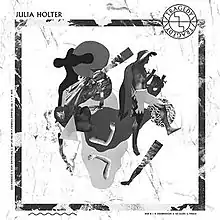Tragedy (Julia Holter album)
Tragedy is the first studio album by the American musician Julia Holter, released by Leaving Records on August 30, 2011.[2] Pitchfork wrote that Tragedy was Holter's "first LP... [which] calls to mind the arty, austere work of Laurie Anderson, Grouper, and Meredith Monk".[3]
| Tragedy | ||||
|---|---|---|---|---|
 | ||||
| Studio album by | ||||
| Released | August 30, 2011 | |||
| Genre | ||||
| Length | 51:15 | |||
| Label | Night School Records[1] | |||
| Producer | Julia Holter | |||
| Julia Holter chronology | ||||
| ||||
The album is inspired by Hippolytus, a play by Euripides.[4] Holter recorded Tragedy with electronic instrumentation, largely out of necessity, since she lacked the funds to hire session musicians.[5]
Reception
| Review scores | |
|---|---|
| Source | Rating |
| The List | |
| Pitchfork | 8/10[3] |
Tragedy was received positively by music critics, who cited Holter as an innovative avant-garde electronic artist.[5] Mike Powell, reviewing the album for Pitchfork, wrote that "Holter has made a dreamy, intense album that aligns with a variety of traditions but, like a lot of great contemporary music, synthesizes them in novel or at least artful ways".[3]
Track listing
| No. | Title | Length |
|---|---|---|
| 1. | "Introduction" | 3:08 |
| 2. | "Try to Make Yourself a Work of Art" | 6:55 |
| 3. | "The Falling Age" | 9:14 |
| 4. | "Goddess Eyes" | 3:25 |
| 5. | "Interlude" | 2:26 |
| 6. | "Celebration" | 9:49 |
| 7. | "So Lillies" | 7:19 |
| 8. | "Tragedy Finale" | 8:05 |
| Total length: | 51:15 | |
References
- "Night School - LSS008: JULIA HOLTER - 'Tragedy' CD". Night School Records. Retrieved October 13, 2015.
- "Allmusic biography of Julia Holter", AllMusic. Retrieved November 5, 2018.
- Mike Powell (2011) "Tragedy - Julia Holter" Pitchfork, October 19, 2011. Retrieved February 29, 2016.
- Welsh, Margaret (September 26, 2012). "Julia Holter gets comfortable with working together". Pittsburgh City Paper. Pittsburgh, PA. Retrieved February 27, 2015.
- Logan Austin (2016) "Julia Holter: Have You in My Wilderness", PopMatters, February 22, 2016. Retrieved February 29, 2016.
- https://www.list.co.uk/article/41671-julia-holter-tragedy/